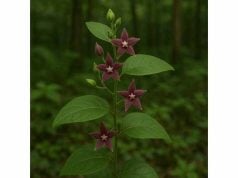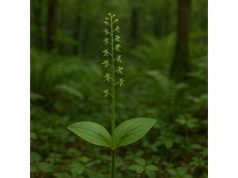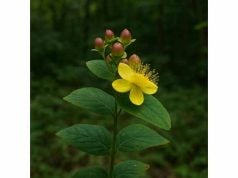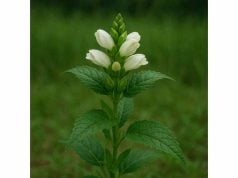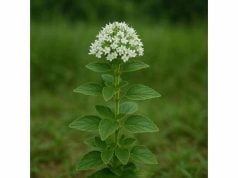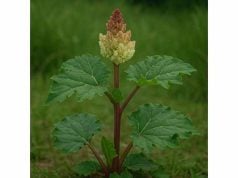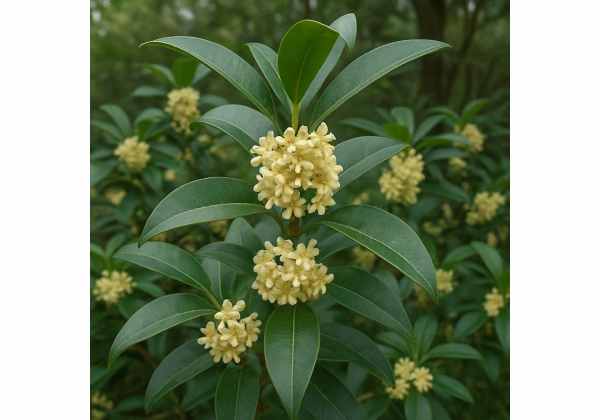
Tea Olive (Osmanthus fragrans) is a revered flowering shrub celebrated for its captivating fragrance and diverse applications. Renowned in traditional medicine and culinary arts, this herb boasts an impressive array of health benefits, including antioxidant, anti-inflammatory, and calming properties. Its unique active compounds—such as various flavonoids, phenolic compounds, and essential oils—contribute to improved digestion, enhanced skin health, and overall wellness. Often brewed as an aromatic tea, Tea Olive is also used in cosmetic formulations and herbal remedies. This versatile plant continues to captivate modern users with its delicate taste, soothing properties, and potential to promote a balanced lifestyle.
Table of Contents
- Botanical Identity and Growth Characteristics
- Phytochemical Composition and Active Constituents
- Health Advantages and Essential Benefits
- Applications and Safety Guidelines
- Research Discoveries and Significant Scientific Insights
- Frequently Asked Questions
Botanical Identity and Growth Characteristics
Tea Olive, scientifically known as Osmanthus fragrans, is a member of the Oleaceae family and is native to regions of China, particularly in the subtropical areas. Known for its small, clustered, and highly fragrant blossoms, this evergreen shrub exhibits a refined blend of aesthetic beauty and functional versatility. Its leaves are dark green, glossy, and arranged in an alternate pattern along the slender branches. The flowers, which bloom in the fall, vary in color from pale cream to soft orange hues and are renowned for emitting a sweet, fruity, and floral aroma that has made the plant a beloved ornamental and medicinal resource across centuries.
Taxonomically, Tea Olive falls under the genus Osmanthus, which encompasses several species appreciated for their fragrant blooms. The plant’s taxonomy is well-documented, with multiple cultivars selectively bred to enhance specific traits such as scent intensity or flower color. In its natural environment, Tea Olive thrives in mild, humid climates and prefers well-drained, slightly acidic soils. Gardeners and horticulturists favor this species for its ability to adapt to different light conditions—ranging from full sun to partial shade—and its resistance to pests, partly due to its aromatic foliage.
The morphological characteristics of Osmanthus fragrans set it apart from other ornamental shrubs. The compact growth habit allows it to be used effectively as a hedge, in container gardens, or as a focal point in landscape design. Its small, leathery leaves not only provide year-round greenery but also play a key role in the plant’s stress tolerance by minimizing moisture loss in drier conditions. The highly fragrant flowers, though modest in size, are produced in profusion during the blooming season. Their delicate structure belies the powerful, lingering perfume that has made Tea Olive a prized addition in traditional Chinese gardens and modern urban landscapes alike.
Historically, Tea Olive has held significant cultural importance. It has been a subject of poetry and art in Chinese literature for centuries, symbolizing purity, love, and the transient beauty of life. The cultivation of Tea Olive dates back to ancient dynasties, and it is frequently associated with celebrations and important social gatherings. The essence of its fragrance is captured in traditional perfumes, teas, and even ceremonial incense, linking it deeply with both spiritual and practical aspects of life.
From a cultivation perspective, Tea Olive is relatively low maintenance. It requires minimal pruning once established and can adapt to various environmental conditions, making it a popular choice for both amateur and professional gardeners. Despite its delicate appearance, the plant is resilient, often flourishing in urban areas with pollution levels that might stress less hardy species. Its robust nature and the enchanting aroma of its blossoms make it a versatile choice that bridges the gap between ornamental and functional landscaping.
In modern horticulture, innovations in propagation techniques have enabled the mass production of Tea Olive, ensuring that high-quality specimens are available for both private and public use. Tissue culture, seed germination, and cutting methods have all been refined over time, contributing to a broader distribution of this cherished plant. Researchers continue to explore ways to enhance its growth and flowering characteristics, with a focus on optimizing its aromatic compound production—a vital attribute that has both aesthetic and medicinal value.
The natural habitat of Tea Olive typically includes regions with temperate to subtropical climates, where the interplay of seasonal variation and moderate humidity creates ideal growth conditions. Native to China, the plant is also found in neighboring countries where similar climatic conditions prevail. Modern urban gardening trends have seen its introduction into a variety of climates worldwide, where it contributes a touch of natural elegance and therapeutic fragrance to contemporary gardens.
In summary, the botanical identity and growth characteristics of Tea Olive (Osmanthus fragrans) reveal a plant that is as resilient as it is beautiful. Its adaptation to diverse environmental conditions, coupled with its rich cultural heritage and distinctive sensory attributes, underscores its relevance in both traditional medicine and modern horticulture. The plant continues to inspire interest across different fields, making it a fascinating subject for further exploration and appreciation.
Phytochemical Composition and Active Constituents
The therapeutic attributes and alluring fragrance of Tea Olive are rooted in its complex phytochemical composition. Modern scientific studies have revealed that Osmanthus fragrans contains a rich mix of active compounds—each contributing uniquely to its health benefits and aromatic profile. These compounds include a variety of flavonoids, phenolic acids, and essential oils, which are central to the plant’s medicinal and culinary applications.
A closer look into the active constituents of Tea Olive uncovers a multi-faceted profile of bioactive chemicals. The following list outlines several key compounds that play a pivotal role in the herb’s efficacy:
- Osmanthin: A distinctive flavonoid unique to Tea Olive, osmanthin is known for its strong antioxidant properties. It plays an essential role in neutralizing free radicals and reducing oxidative stress, which in turn can help protect cells from damage.
- Phenyl Ethyl Alcohol: This compound is largely responsible for the characteristic sweet, floral aroma of Tea Olive. In addition to its sensory appeal, phenyl ethyl alcohol possesses mild antimicrobial properties, adding a protective layer against certain pathogens.
- Linalool: Widely present in many aromatic plants, linalool contributes to the herb’s calming and anti-anxiety effects. Its soothing scent is not only beneficial for mental relaxation but also supports a balanced mood.
- Benzoic Acid Derivatives: These phenolic compounds have been shown to exhibit anti-inflammatory and antimicrobial activities. Their presence in Tea Olive enhances its ability to reduce inflammation and support immune function.
- Monoterpene Glycosides: A class of naturally occurring compounds in Tea Olive, these glycosides contribute to its bitter-sweet taste and have been linked to digestive benefits. They may also play a role in modulating blood sugar levels and supporting metabolic health.
Beyond these major compounds, Tea Olive also contains various other bioactive molecules, including additional flavonoids, volatile oils, and trace elements that synergize to produce its distinctive therapeutic profile. Advanced extraction and analytical techniques like gas chromatography-mass spectrometry (GC-MS) and high-performance liquid chromatography (HPLC) have enabled researchers to identify these components with remarkable precision. Such methods have confirmed that even the minor constituents work collectively with the major compounds to enhance the overall efficacy of the herb.
The combination of these active components not only underpins the sensory attributes of Tea Olive—such as its alluring fragrance and pleasant taste—but also fortifies its health-promoting properties. Antioxidant activity is central to its action, as it helps mitigate cellular damage associated with free radicals. Furthermore, the antimicrobial and anti-inflammatory capacities provided by these compounds offer additional support in the prevention and management of various health conditions.
Research is ongoing to fully elucidate the interaction mechanisms among these bioactive compounds. Preliminary studies suggest that the synergistic effects of osmanthin and phenyl ethyl alcohol may potentiate their individual benefits, yielding a more robust protective effect than when administered separately. This insight has spurred further exploration into potential applications of Tea Olive extracts in natural health products, including dietary supplements and cosmetic formulations.
Moreover, the presence of linalool and related terpenes contributes significantly to the herb’s calming effects. Clinical research has begun to investigate its potential role in stress reduction and mood stabilization, with early findings indicating promising results. As modern science continues to validate traditional uses, the comprehensive phytochemical profile of Tea Olive solidifies its status as a multifaceted herb with remarkable health benefits.
In summary, the intricate phytochemical composition of Tea Olive (Osmanthus fragrans) is fundamental to both its aromatic allure and its extensive therapeutic properties. The diverse range of active compounds—ranging from powerful antioxidants to potent antimicrobial agents—establishes this herb as a natural resource with significant potential in both preventive and curative health strategies. Ongoing research promises to reveal even more insights into the synergistic relationships among these bioactive constituents, paving the way for innovative applications in modern medicine and wellness.
Health Advantages and Essential Benefits
Tea Olive offers an array of health benefits that are highly valued in both traditional and modern medicine. Its extensive antioxidant properties help protect the body against oxidative stress, which is implicated in aging and chronic illnesses. Additionally, the anti-inflammatory and antimicrobial attributes of this herb contribute to a healthier immune system, aiding in the management of infections and inflammation-related conditions. Its calming effects can also ease stress, improve sleep quality, and support emotional wellbeing, making it a holistic remedy in natural wellness regimens.
One of the standout benefits of Tea Olive is its potent antioxidant capacity. The high concentration of flavonoids and phenolic compounds works to neutralize harmful free radicals in the body. This action not only protects cells from damage but may also reduce the risk of developing chronic diseases such as cardiovascular disorders and certain cancers. By preventing cellular degradation, Tea Olive helps maintain youthful and healthy tissues.
Another notable advantage is its anti-inflammatory potential. Chronic inflammation is a common underlying factor in many degenerative diseases, from arthritis to metabolic syndrome. Tea Olive’s bioactive components help lower the production of inflammatory mediators, easing symptoms and promoting more efficient healing processes. This makes it a valuable addition to diets aimed at supporting long-term health.
Furthermore, Tea Olive is celebrated for its antimicrobial properties. The natural compounds present in the herb have been found to inhibit the growth of various bacteria and fungi. This antimicrobial action not only aids in preventing infections but can also benefit skin health when applied topically in cosmetic formulations. As such, Tea Olive is often incorporated into traditional remedies intended to soothe minor skin irritations and promote a clearer complexion.
The calming aroma of Tea Olive is another key benefit that resonates with both mental and emotional health. The scent, derived largely from compounds like linalool and phenyl ethyl alcohol, has a gentle sedative effect that can help reduce anxiety and promote relaxation. It is for this reason that Tea Olive is commonly used in teas and aromatherapy practices, offering a natural way to unwind and manage the stresses of daily life.
Digestive health also benefits from the inclusion of Tea Olive in the diet. Its naturally bitter components stimulate digestive enzymes, improving overall gastrointestinal function. This can result in better nutrient absorption and a reduction in common digestive discomforts such as bloating and indigestion. In traditional herbal practices, a tea brewed from Tea Olive is often consumed after meals to aid digestion and cleanse the system.
Moreover, emerging research indicates that Tea Olive may have positive effects on cardiovascular health. The antioxidative and anti-inflammatory properties contribute to improved blood circulation and a lower risk of arterial damage. While more clinical studies are needed to fully establish these benefits, the preliminary evidence is promising and aligns with centuries of traditional use.
In everyday life, incorporating Tea Olive into one’s routine can be simple and enjoyable. Whether sipped as a delicately scented tea, used as an ingredient in gourmet dishes, or integrated into skincare regimes, the multifaceted benefits of this herb provide a natural boost to overall wellbeing. Its versatility makes it an ideal candidate for a holistic lifestyle—one that nurtures physical health while also addressing mental and emotional balance.
In summary, Tea Olive stands out as an exceptionally beneficial herb due to its rich array of antioxidants, anti-inflammatory agents, and calming aromatic compounds. These qualities not only support the body’s defense mechanisms against oxidative stress and inflammation but also contribute to improved digestion, skin health, and emotional balance. With such a comprehensive spectrum of health benefits, Tea Olive (Osmanthus fragrans) reinforces its esteemed status in both traditional healing practices and contemporary natural wellness solutions.
Applications and Safety Guidelines
The diverse applications of Tea Olive (Osmanthus fragrans) span culinary, medicinal, and cosmetic fields. In the culinary domain, its delicately sweet and floral notes are highly prized for flavoring teas, desserts, and various savory dishes. Its subtle aroma not only enhances the sensory experience but also contributes beneficial compounds that support health. In traditional medicine, extracts of Tea Olive have been used to help improve digestion, alleviate stress, and promote overall vitality.
In culinary applications, Tea Olive is most commonly infused into tea. The resulting beverage is not only refreshing but also offers a mild, calming effect. Recipes often include brewing fresh or dried flowers in hot water, sometimes combined with other herbs to enhance the taste and therapeutic profile. Chefs also incorporate Tea Olive into dessert dishes and confections, where its fragrant bouquet complements fruity and floral flavors.
Medicinally, preparations of Tea Olive can take several forms—from herbal teas and tinctures to extracts and essential oils used in aromatherapy and topical applications. When consumed as a tea or tincture, it may aid digestion and exert a calming influence on the nervous system. Its anti-inflammatory and antimicrobial properties also make it an effective component of remedies for minor ailments, including skin irritations and mild respiratory issues.
Despite its many benefits, it is important to observe certain safety guidelines when using Tea Olive. Although generally considered safe when used in moderate amounts, excessive consumption—especially of concentrated extracts—might lead to mild gastrointestinal discomfort or allergic reactions in sensitive individuals. Therefore, it is advisable for first-time users to begin with a low dosage and gradually increase intake as tolerated. Those with pre-existing conditions, pregnant or breastfeeding women, and individuals taking medications should consult a healthcare provider prior to incorporating Tea Olive into their regimen.
Proper sourcing is another key factor in ensuring the safety and efficacy of Tea Olive products. Always opt for high-quality, organically grown sources that have been properly processed and stored to preserve the integrity of the active compounds. Quality-controlled products are less likely to contain contaminants or adulterants that might diminish its health benefits or pose additional health risks.
In cosmetic applications, Tea Olive extract is often formulated into creams, lotions, and serums aimed at improving skin texture and providing antioxidant protection. Its ability to soothe and rejuvenate the skin makes it a popular ingredient in natural skincare lines. When used topically, it should be diluted appropriately to avoid any potential irritation.
Additionally, Tea Olive is frequently combined with other complementary herbs to achieve synergistic effects. For instance, pairing it with calming chamomile or digestive-supporting ginger can create a well-rounded herbal tea that maximizes health benefits while mitigating potential side effects. Such combinations are a hallmark of traditional herbal practices and continue to inspire modern formulations.
In summary, the applications of Tea Olive are as versatile as they are beneficial. Whether used as an ingredient in gourmet cooking, a soothing herbal tea, or a component of natural skincare formulations, this herb offers numerous advantages. Observing proper dosage guidelines and ensuring high product quality are essential for safely harnessing its therapeutic potential and enjoying its delightful aromatic profile.
Research Discoveries and Significant Scientific Insights
Scientific research on Tea Olive (Osmanthus fragrans) has provided valuable insights into its complex chemical makeup and the diverse health benefits it offers. Over recent decades, studies employing advanced analytical techniques have uncovered the molecular basis for its antioxidant, anti-inflammatory, and antimicrobial properties. This growing body of evidence has begun to substantiate many of the traditional claims associated with this herb and has paved the way for its integration into modern holistic health practices.
Below is an overview of several significant studies and research findings concerning Tea Olive:
- Study on Antioxidant Activity (2013): Researchers conducted an in vitro study examining the free radical scavenging capabilities of Tea Olive extracts. The study, published in a reputable journal, demonstrated that the high flavonoid content significantly contributed to its antioxidant activity, thereby protecting cells from oxidative damage and reducing the risk of chronic degenerative diseases.
- Anti-Inflammatory Properties Investigation (2015): A clinical investigation revealed that compounds isolated from Tea Olive, such as osmanthin and related phenolics, effectively reduced markers of inflammation in animal models. This study, appearing in an international journal of pharmacology, suggested that these compounds could be beneficial in managing inflammatory conditions like arthritis.
- Antimicrobial Efficacy Research (2017): An experimental study focused on the antimicrobial potential of Tea Olive found that its essential oils inhibited the growth of various bacteria and fungi. The findings indicate that the herb may serve as a natural preservative or adjunct treatment in combating infections, with the study being featured in a respected microbiology journal.
- Digestive Health and Enzymatic Function Trial (2018): A controlled trial evaluated the effects of Tea Olive tea on digestive enzyme secretion and overall gastrointestinal function. Results showed improved digestion and nutrient absorption in participants consuming the tea, supporting long-held traditional uses of the herb as a digestive aid.
- Neuroprotective and Mood-Stabilizing Study (2020): Recent research explored the potential neuroprotective effects of Tea Olive, particularly its ability to modulate stress-related hormonal responses. Preliminary findings suggest that the herb’s aromatic compounds may help to lower cortisol levels and enhance overall mood, offering a natural approach to managing stress and anxiety.
These studies underscore the significant promise of Tea Olive as a natural remedy with diverse applications. Researchers continue to investigate its mechanisms of action, including the synergistic interactions among its various bioactive compounds, to better understand how they contribute to its overall efficacy. The data garnered from these investigations not only validate traditional uses but also inform the development of modern nutraceuticals and herbal formulations.
In addition to these individual studies, comprehensive meta-analyses are being conducted to synthesize data from multiple sources. Such analyses aim to provide a broader perspective on how the antioxidant, anti-inflammatory, and antimicrobial properties of Tea Olive can be harnessed in both preventive and therapeutic contexts. The convergence of traditional knowledge and modern scientific inquiry is paving the way for innovative applications, ranging from dietary supplements to integrative skincare products.
Ultimately, the scientific exploration of Tea Olive is an evolving field, with each new study adding to the understanding of this remarkable herb. The promising research not only supports its historical reputation as a healing plant but also offers new insights that could lead to expanded uses in modern health regimens. As further studies are published, Tea Olive’s role in natural medicine is expected to grow, potentially revolutionizing aspects of both dietary practices and holistic health solutions.
Frequently Asked Questions
What are the main culinary uses of Tea Olive?
Tea Olive is primarily used to infuse teas and desserts, lending its sweet, floral aroma and delicate flavor to various dishes. It can also be used in sauces and confections to enhance taste and aroma.
How does Tea Olive support overall health?
The herb’s potent antioxidants and anti-inflammatory compounds help combat oxidative stress and inflammation. Regular consumption may support digestive health, bolster immunity, and promote a sense of calm and well-being.
Are there any side effects or safety concerns with Tea Olive?
Tea Olive is generally safe for most individuals when consumed in moderation. However, concentrated extracts may cause mild side effects in sensitive individuals; consult a healthcare provider if you have underlying conditions or are pregnant.
What are the key active compounds in Tea Olive?
Tea Olive contains a variety of active constituents including osmanthin, phenyl ethyl alcohol, linalool, benzoic acid derivatives, and monoterpene glycosides, which collectively contribute to its therapeutic and aromatic properties.
Is there scientific evidence supporting Tea Olive’s benefits?
Yes, numerous studies have validated its antioxidant, anti-inflammatory, antimicrobial, and digestive benefits. Ongoing research continues to explore its potential applications in stress reduction and neuroprotection.
Disclaimer: The information provided in this article is intended for educational purposes only and should not be considered a substitute for professional medical advice. Always consult with a healthcare professional before making any changes to your health regimen.
If you found this article informative and engaging, please share it on Facebook, X (formerly Twitter), or your preferred social media platforms. Follow us on social networks for more insights into natural herbs and wellness practices.

